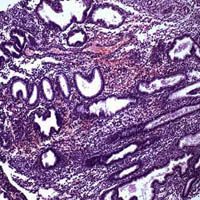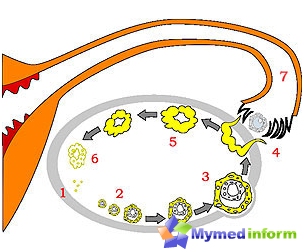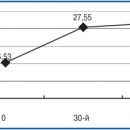Endometrial hyperplasia is an increase in the tissue area and serves as a cancer disease signal. However, endometrial hyperplasia has a benign nature and only in some cases acquires the nature of the precancerous disease.
Content
Concept about endometrial hyperplasia
 Hyperplasia in medicine is called an increase in the number of cells in any tissue or body, as a result of which the volume of this organ or tissue area increases. This growth of tissue or organ can serve as a signal of the threat of cancer, and may exist independently of the presence or absence of cancer processes in the patient.
Hyperplasia in medicine is called an increase in the number of cells in any tissue or body, as a result of which the volume of this organ or tissue area increases. This growth of tissue or organ can serve as a signal of the threat of cancer, and may exist independently of the presence or absence of cancer processes in the patient.
Many organs and tissues of the human body are subject to hyperplastic processes, in particular, in women, endometrium - mucous membrane, lining the uterus.
Consequently, endometrial hyperplasia is a benign growth of endometrial tissue, but hyperplastic processes in endometrials have an unequal degree of development and in some cases acquire the nature of the precancerous disease.
Endometrium hyperplasia is divided into the following types:
- Endometrium iron hyperplasia
- iron-cystic hyperplasia
- Atypical endometrial hyperplasia (it is adenomatosis, adenomatous hyperplasia)
- Roleberry and iron-fibrous polyps endometrial
Differences between these types of hyperplasia are interested in mostly medical professionals, but some data may be important for «simple mortals». First of all, this concerns the fact that not all types of endometrial hyperplasia can go to cancer.
The pre-cancerous disease doctors consider atypical hyperplasia (adenomatosis) endometrial in its diffuse and focal forms. Atypical endometrial hyperplasia goes into endometrial cancer in about 10% of cases. The development of the oncological process can be long, in the early stages it is quite successfully cured. But in order not to launch the process, patients with adenomatosis should be under particularly thorough permanent medical control.
As for the iron and iron-cystic hyperplasia, they, in the opinion of most scientists, are not considered precancerous diseases.
In essence, iron and iron-cystic hyperplasia - this is the same process expressed in varying degrees. With iron hyperplasia, as applied from its name, glandular fabric. With the iron-cystic form of endometrial hyperplasia in the same extended iron tissue are cysts. By and large, this is the only difference between the hardware and iron-cystic forms of endometrial hyperplasia and the principal difference between them.
Rare varieties of iron-cystic hyperplasia are stromal hyperplasia, which is characterized by the presence of large, sometimes polymorphic stroma cell nuclei, as well as basal hyperplasia, for which the thickening of the base layer of the mucous membrane is characterized.
Causes of disease development
 The causes of the occurrence of hyperplastic processes in endometrial tissues can be different. Most often, this pathology develops due to violations of the hormonal balance, as well as carbohydrate, lipid and other types of metabolism.
The causes of the occurrence of hyperplastic processes in endometrial tissues can be different. Most often, this pathology develops due to violations of the hormonal balance, as well as carbohydrate, lipid and other types of metabolism.
Inheritance, the presence of uterine and other diseases and other diseases, hypertension and other diseases, manifestations of damaging effects during the intrauterine period of development, disease during puberty and caused by the reproductive function caused by them.
The emergence of hyperplasia in mature age is often preceded by transferring gynecological diseases, abortions, operations on genitals.
In addition, we can say that some of the conditions of the body, not being the immediate cause of the development of endometrial hyperplasia, accompany it, this is:
- obesity
- hypertonic disease
- hyperglycemia
- Mastopathy
- Endometriosis
- Liver function disorders responsible for hormone metabolism
As for the direct causes of endometrial hyperplasia, they are most often some ovulation disorders for which absolute or relative hyperkers are characteristic of. This pathology is more common in adolescent girls and in women during premopause, and less rarely in childbearing age, subject to unstable regulation of the functions of the reproductive system.









